Elsevier Encyclopedia of Geology - vol I A-E
Подождите немного. Документ загружается.

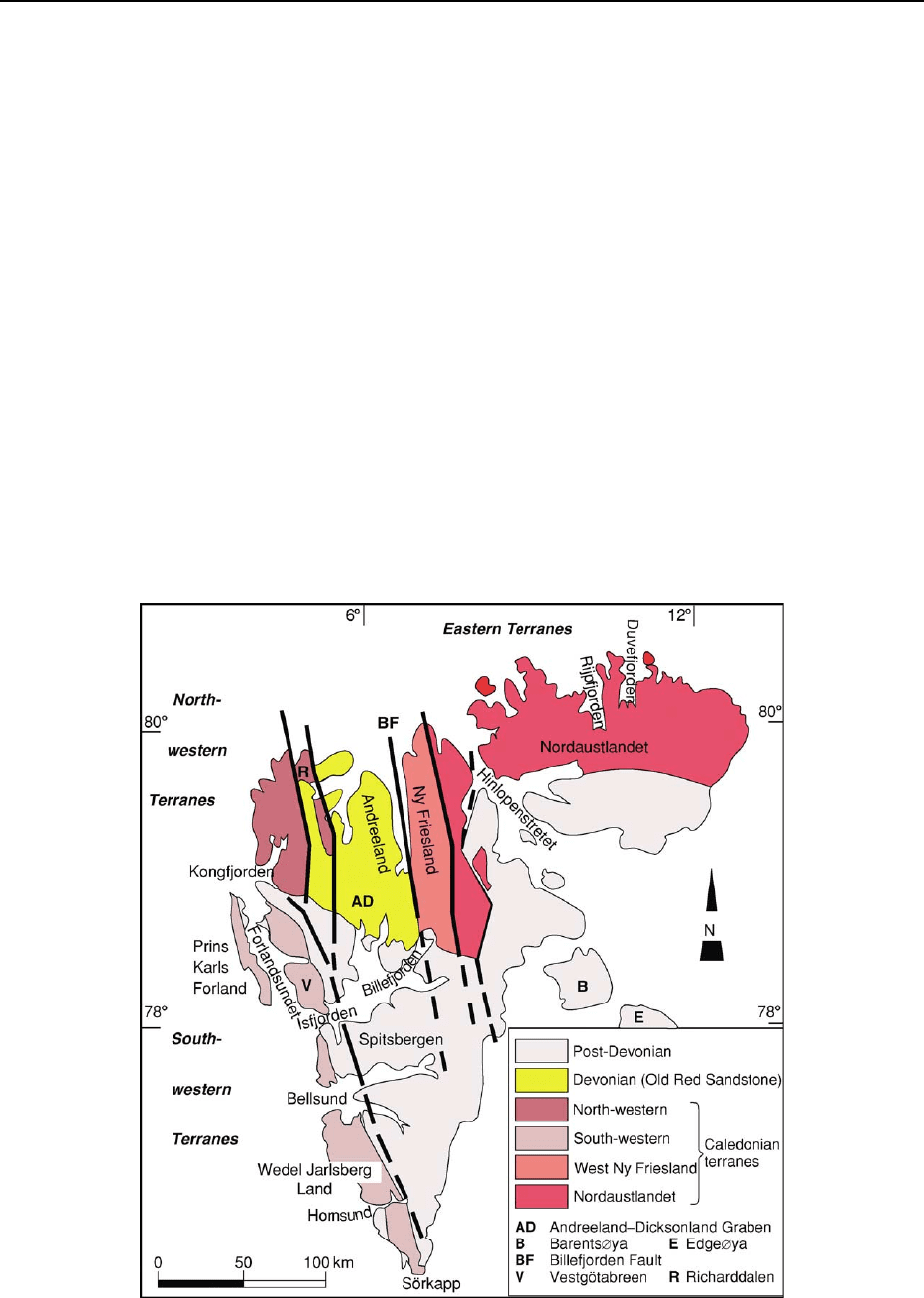
thrusting may have started in the Late Ordovician, the
timing of the collisional orogeny in eastern Greenland
coincided with that in the Scandes. In marked contrast
to the Scandes, however, major post-kinematic granite
plutons are present.
Svalbard
The Svalbard Archipelago (Figure 4), located on
the north-western corner of the Barents Shelf, is
dominated by a larger island, Spitsbergen, which is
flanked to the east by Nordaustlandet, Barentsøya,
and Edgeøya. Numerous other smaller islands are
part of the archipelago, which reaches as far east as
Kvitøya and south to Bjørnøya. The western and
northern parts of the archipelago are dominated by
Caledonian bedrock, including Old Red Sandstones;
Carboniferous and younger successions unconform-
ably overlie this ‘basement’, occurring in a major
syncline that dominates the structure of the central
and southern parts of the archipelago. These younger
successions extend eastwards and southwards over
much of the Barents Shelf. Along the western coast
of Spitsbergen, a Tertiary east-verging fold-and-thrust
belt is superimposed on the older structures.
Prior to the opening of the northernmost Atlantic
and the Fram Strait, Svalbard’s Caledonian bedrock
was a direct northern extension of the East Greenland
Caledonides (Figure 1). On Svalbard, the Caledonian
rocks generally strike northwards and are split by
major north-trending faults and Old Red Sandstone
graben. Various provinces, or terranes, have been
recognized, and nearly all can be related directly to
the East Greenland Caledonides. However, the excep-
tion is important and occurs along the west coast of
Spitsbergen.
Svalbard’s eastern province (Figure 4) is readily
divisible into two terranes, Nordaustlandet (includ-
ing Kvitøya and eastern Ny Friesland) and West Ny
Friesland. The Nordaustlandet Terrane is character-
ized by the typical Laurentian Cambro-Ordovician
carbonate platform succession overlying tillites and
thick Neoproterozoic dolomites, limestones, sand-
stones, and shales. Major unconformities separate
Figure 4 The Svalbard Caledonides.
70 EUROPE/Scandinavian Caledonides (with Greenland)
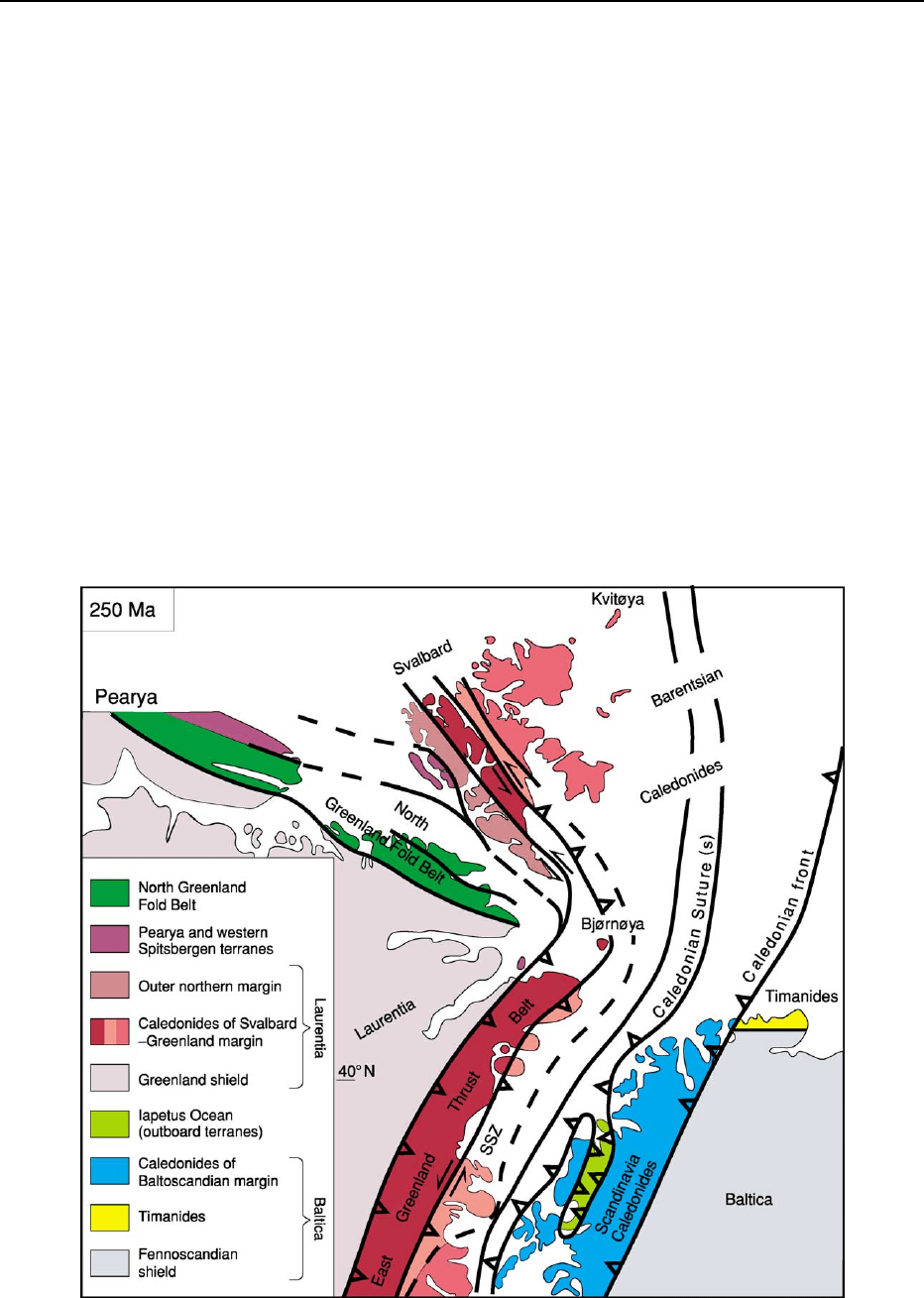
this succession from a Late Grenvillian basement of
andesites and rhyolites and underlying meta-turbidites
of latest Mesoproterozoic or earliest Neoproterozoic
age, intruded syntectonically by ca. 950 Ma gran-
ites. Upright to west-verging folding characterizes
this easternmost Svalbard Terrane, and the grade
of Caledonian metamorphism increases eastwards,
with migmatization of the eastern parts of Nordaust-
landet and the island of Kvitøya. Late-orogenic gran-
ites (ca. 420–410 Ma) also characterize this terrane,
which, in all respects, compares closely with the
highest allochthon of the central East Greenland
Caledonides.
The Nordaustlandet Terrane is thrust westwards
onto a succession of high amphibolite facies orthog-
neisses and isoclinally folded metasediments that is
nearly 10 km thick – the Atomfjella Complex. The
metasediments are dominated by quartzites, but also
include marble and schist formations; the ortho-
gneisses are mainly metagranites, dated at 1750 Ma.
In both the metagranites and the quartzites, metado-
lerites are ubiquitous. Dating of detrital zircon has
shown that the quartzites are Mesoproterozoic in age,
but probably not younger than 1300 Ma (the age
of the metadolerites), and that the marble and schist
formations are latest Mesoproterozoic or younger.
The Late Palaeoproterozoic ‘basement’ metagran-
ites are repeated by thrusting at least three times in a
major north-trending antiform that dominates the
structure of western Ny Friesland. Only Caledonian
(ca. 430–410 Ma) argon–argon ages of meta-
morphism have been obtained from the Atomfjella
Complex; evidence of Grenvillian tectonothermal
activity is notable by its absence.
The West Ny Friesland Terrane is closely compar-
able with the ‘thick-skinned’ allochthon of north-east
Greenland, in terms of both the stratigraphy and the
character of the Caledonian deformation and meta-
morphism. Taken together with the evidence (above)
for the comparability of the Nordaustlandet Terrane
and the central East Greenland allochthons, there can
be little doubt that Svalbard’s eastern Caledonian
terranes are a direct northerly continuation of the
East Greenland Caledonides (Figure 5). In much of
Figure 5 The Arctic Caledonides and Laurentia–Baltica relationships in the Early Mesozoic.
EUROPE/Scandinavian Caledonides (with Greenland) 71
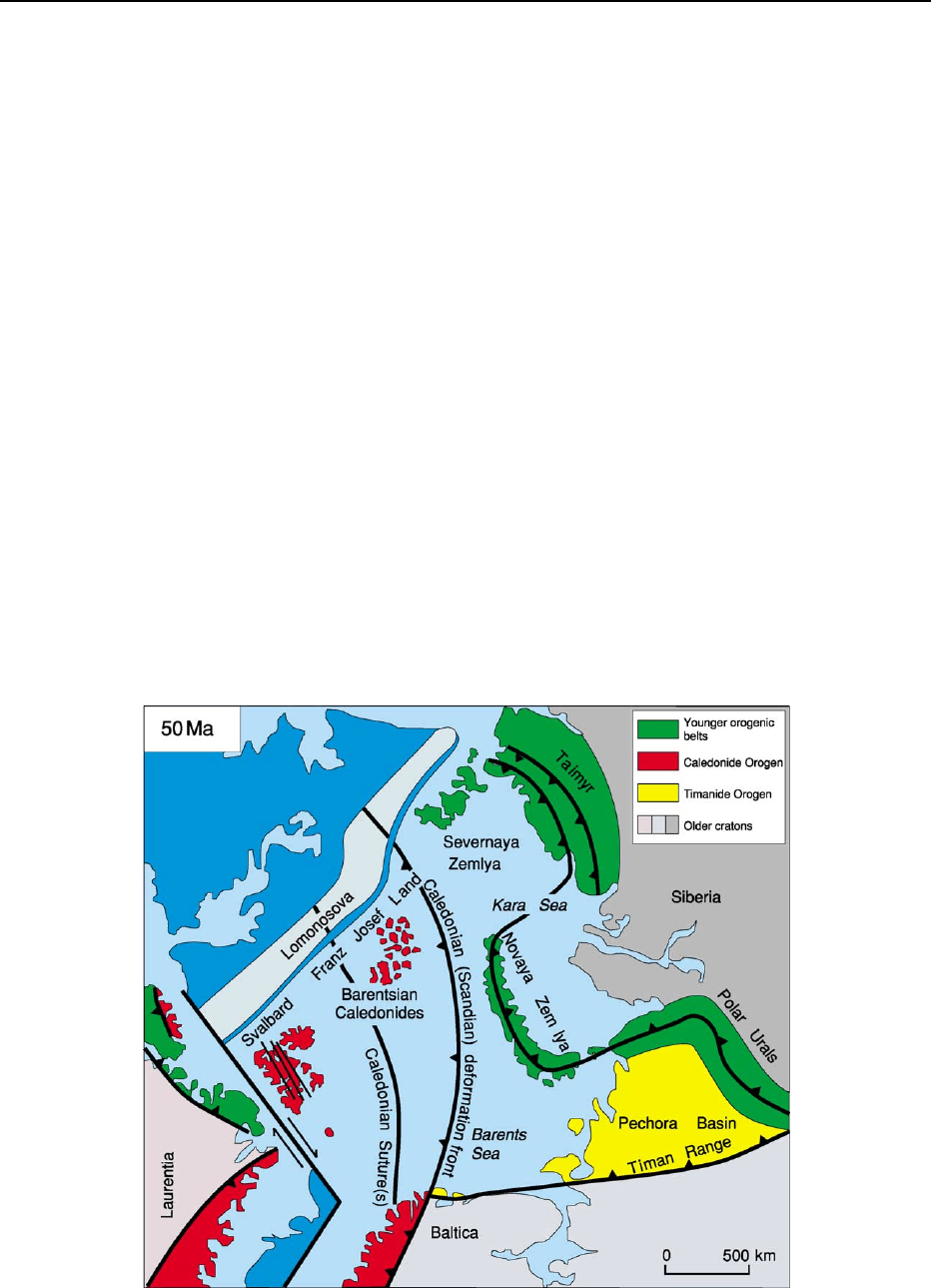
the previous literature on the Svalbard Caledonides, a
hypothesis has been favoured that these eastern ter-
ranes are derived from an off-shore area to the east of
central East Greenland, implying sinistral transport
over a distance of at least 1000 km; this hypothesis is
not supported by recent investigations of Svalbard
and Greenland.
Svalbard’s eastern Caledonides are separated from
the western terranes by the 50 km wide Andree
´
land–
Dicksonland Old Red Sandstone graben. The Cale-
donian bedrock, from north-western Spitsbergen
southwards via the west-coast Tertiary fold-and-thrust
belt to southernmost areas and further south to Bjør-
nøya, provides evidence of both Laurentian-platform
affinities and an outboard subduction-related terrane.
Unambiguous Laurentian lithological and faunal
signatures are found on Bjørnøya and southernmost
Spitsbergen, where Cambro-Ordovician carbonate
successions are closely related to strata of the same
age in north-eastern Greenland. The underlying Neo-
proterozoic carbonate and siliciclastic successions are
also comparable with those in this part of Greenland,
but, interestingly, the metamorphic complexes uncon-
formably underlying these sedimentary rocks are of
Grenvillian age, a characteristic that is unknown in
north-eastern Greenland.
In central western Spitsbergen, Neoproterozoic
successions, including thick tillites, are overthrust by
a blueschist and eclogite assemblage (the Vestgo
¨
ta-
breen Complex). The high pressure–low temperature
metamorphism occurred in the Early Ordovician and
was followed by thrusting to high structural levels,
erosion, and deposition of a mid–Late Ordovician
conglomerate and limestone succession, passing up
into Silurian turbidites. The subduction-related Vest-
go
¨
tabreen Complex is thought to be related to the
Pearya Terrane of northernmost Canada (Ellesmere
Island), both being foreign to Laurentia.
As shown in Figure 6, the Caledonian terranes of
Svalbard comprise the western part of an orogen that
extends northwards from the Scandes beneath the
Barents Shelf to the edge of the Eurasian Basin. This
part of the orogen is called the Barentsian Caledo-
nides. Prior to the opening of the Eurasian Basin in
the Tertiary, the Barentsian Caledonides are thought
to have crossed Lomonosova (today’s Lomonosov
Ridge) and may have continued into the continental
shelves of the Amerasian Basin.
The eastern side of the Barentsian Caledonides
is flanked by the Timanides, a Late Neoproterozoic
orogen that dominates the bedrock of north-eastern-
most Europe. The Timanides strike north-westwards
Figure 6 Tectonic elements of the western Eurasian Arctic in the Early Tertiary, during the initial opening of the Eurasian Basin and
the Norwegian and Greenland seas (light blue, shelf and ridges; deep blue, ocean floor).
72 EUROPE/Scandinavian Caledonides (with Greenland)
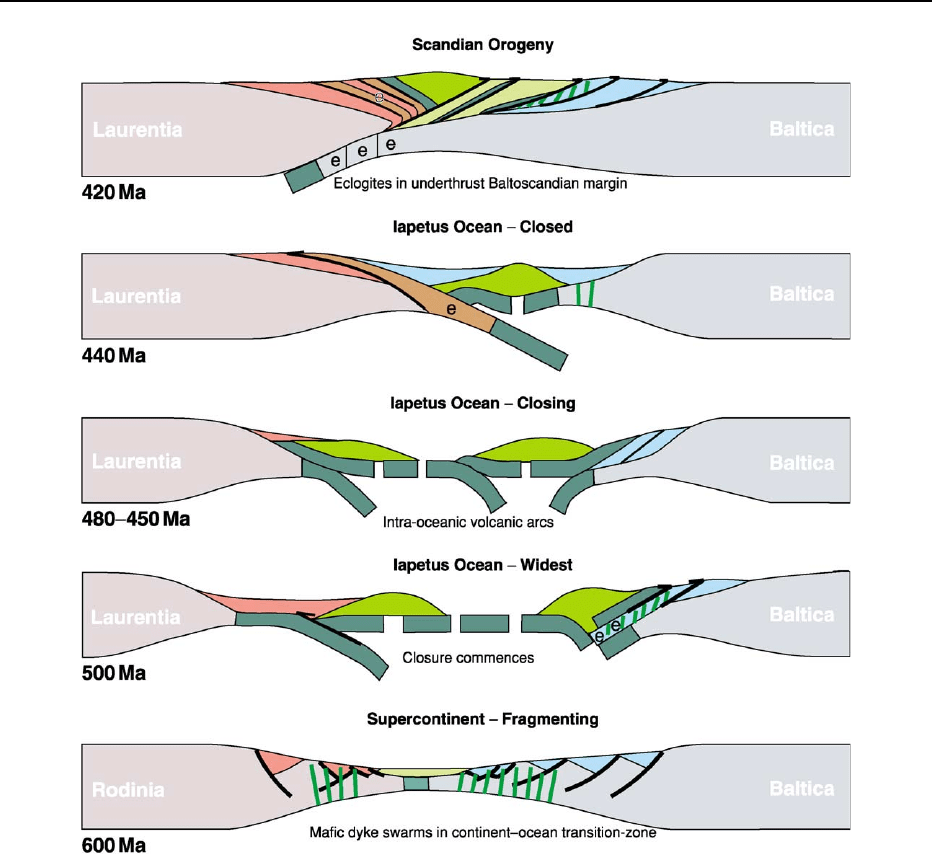
from a type area in the Timan Range, beneath the
Pechora Basin, into the Barents Sea. A deep borehole
on Franz Josef Land sampled folded Vendian
turbidites at depth of 2 km; this evidence, along with
geophysical data, suggests that the Barentsian Cale-
donides occur beneath Late Palaeozoic, Mesozoic,
and Tertiary strata over much of the Barents Shelf.
Tectonic Evolution of the Northern
Caledonides
The first interpretations of the North Atlantic Cale-
donides in terms of continental drift and plate tecton-
ics inferred that Laurentia and Baltica were part of a
single supercontinent (Rodina) in the Late Neoproter-
ozoic. The Caledonian cycle was thought to involve
rifting and separation of these continents, with the
opening of a substantial ocean by seafloor spreading,
followed by closure, resulting in a mid-Palaeozoic
configuration that was similar to that which existed
before ocean opening. Palaeomagnetic evidence has
subsequently suggested that Baltica rotated about
120
between the Vendian and the Middle Ordovi-
cian; thus the model of simple opening and closing
(the so-called ‘Wilson cycle’) is not generally accepted
today. However, the structure of the Scandinavian
Caledonides does provide evidence of a tectonic his-
tory that is readily divisible into three parts:
1. a period of Neoproterozoic rifting, leading to the
separation of Baltica from a larger continental
assemblage by the Early Cambrian;
Figure 7 Caledonian tectonic evolution, from the Vendian to the Late Silurian. e; eclogite.
EUROPE/Scandinavian Caledonides (with Greenland) 73

2. opening of the Iapetus Ocean in the Cambrian
and closing during the Ordovician, with subduc-
tion along the margins of both Laurentia and
Baltica; and
3. Scandian collision of Baltica and Laurentia in
the mid-Silurian and Early Devonian, with
underthrusting of the latter by the former.
The Caledonides of eastern Greenland and Svalbard
provide complementary evidence on the character
of the Laurentian margin and allow the reconstruc-
tion of the tectonic evolution of the whole orogen,
which is summarized schematically in Figure 7.
The vast Himalayan-type thrust systems of western
Scandinavia and eastern Greenland, with many hun-
dreds of kilometres of crustal shortening across the
orogen, testify to more-or-less orthogonal collision
of Laurentia and Baltica. Support for this conclusion
is found in the kinematic evidence of west-north-west
and east-south-east transport of the allochthons and
the correlation of thrust complexes over distances
of up to 1000 km along the orogen. This northern
segment of the Caledonides differs markedly from
the type areas of the Caledonide Orogen in the UK
and further to the south-west, where sinistral trans-
pression appears to have dominated the Caledonian
collision of Avalonia and Laurentia.
See Also
Europe: Timanides of Northern Russia; Caledonides of
Britain and Ireland; Permian to Recent Evolution. Plate
Tectonics. Tectonics: Faults; Folding; Mountain Build-
ing and Orogeny.
Further Reading
Andreasson PG (1994) The Baltoscandian margin in Neo-
proterozoic – early Palaeozoic times. Some constraints on
terrane derivation and accretion in the Arctic Scandi-
navian Caledonides. Tectonophysics 231: 1–32.
Birkenmajer K (1981) The geology of Svalbard, the western
part of the Barents Sea, and the continental margin of
Scandinavia. In: Nairn AEM, Churkin M Jr, and Stehli
FG (eds.) The Arctic Ocean, pp. 265–329. The Ocean
Basins and Margins, Part 5. New York: Plenum.
Fortey RA and Bruton DL (1973) Cambrian–Ordovician
rocks adjacent Hinlopenstretet, north Ny Friesland,
Spitsbergen. Geological Society of America Bulletin 84:
2227–2242.
Gee DG (1975) A tectonic model for the central part of the
Scandinavian Caledonides. American Journal of Science
275A: 468–515.
Gee DG and Sturt BA (eds.) (1985) The Caledonides
Orogen – Scandinavia and Related Areas. Chichester:
Wiley.
Gee DG and Tebenkov AM (2005) Svalbard: Frag-
ments of the Laurentian Caledonian Margin. In: Gee
DG and Pease VL (eds.) The Neoproterozoic Timanide
Orogen of Eastern Baltica. London: Geological Society
Memoir.
Grenne T, Ihlen PM, and Vokes FM (1999) Scandinavian
Caledonide Metallogeny in a plate tectonic perspective.
Mineralium Deposita 34: 422–471.
Harland WB (1997) The Geology of Svalbard. Memoir 17.
London: Geoogical Society of London.
Henriksen N, Higgins AK, Kalsbeek F, and Pulvertaft TC
(2000) Greenland from Archaean to Quaternary.
Description text to the Geological map of Greenland
1:2500000. Geology of Greenland Survey Bulletin
185: 1–96.
Higgins AK and Leslie AG (2000) Restoring thrusting
in the East Greenland Caledonides. Geology 28:
1019–1022.
Stephens M (1988) The Scandinavian Caledonides: a
complexity of collisions. Geology Today 4: 20–26.
Stephens MB and Gee DG (1989) Terranes and polyphase
accretionary history in the Scandinavian Caledonides.
Geological Society of America Special Papers 230:
17–30.
Trettin HP (1989) The Arctic Islands. In: Bally AW and
Palmer AR (eds.) The Geology of North America – An
Overview, pp. 349–370. Boulder, Colorado: Geological
Society of America. V. A.
74 EUROPE/Scandinavian Caledonides (with Greenland)

Variscan Orogeny
W Franke, Johann Wolfgang Goethe-Universita
¨
t,
Frankfurt am Main, Germany
P Matte, University of Montpellier II, Montpellier,
France
J Tait, Ludwig-Maximilians-Universita
¨
t, Mu
¨
nchen,
Germany
ß 2005, Elsevier Ltd. All Rights Reserved.
Introduction
Western and Central Europe were consolidated during
an Upper Palaeozoic orogenic event, which has been
named the ‘Variscan’ orogenyafteralegendaryGer-
manic tribe in north-eastern Bavaria, mentioned by the
Roman author Tacitus. The term ‘Variscan’ should be
given preference over ‘Hercynian’, which is often used
for the same orogeny. The latter name is derived from
the Harz Mountains in northern Germany, which do
contain Variscan basement, but which represent a fault
block thrust up during the Late Cretaceous.
Variscan rocks can be traced from Portugal to
Poland and from the British Isles to the Mediterranean.
The Variscan basement is exposed in ‘massifs’,which
emerge from under younger Late Palaeozoic or Meso-
zoic cover. The most important massifs are the Iberian
Massif in Spain, the Armorican Massif, the Massif
Central, and the Maures Massif in France, parts of
Corsica and Sardinia, the Vosges and the Black Forest,
the Ardennes, the Rhenish Massif and the Harz Moun-
tains in west-central Europe, and the Bohemian Massif
further east. In the Alps and Carpathians, as well as
in the Mediterranean realm, the Variscan basement
has been much reworked by the Mesozoic–Cenozoic
‘Alpine’ orogenic processes (see Europe: The Alps).
The extraordinary width of the Variscan belt is the
result of a complex palaeogeographical situation. The
Variscan orogen is actually a collage of major and
minor continental plates (Figures 1 and 2), which
were once separated by at least three oceanic areas.
These plates first spread apart (520–450 Ma), then
converged, and eventually collided with each other
(ca. 420–300 Ma). Sequential collision produced the
huge landmass of Pangaea. By the Early Permian,
the orogenic edifice was largely eroded, and was sub-
sequently covered by Permian, Mesozoic, and Ceno-
zoic deposits. The angular unconformity between
Variscan basement and the cover is one of the key
features of European geology (Figure 3).
There are two complementary ways to reconstruct
such large-scale and long-term processes. Studies
of palaeomagnetism (see Palaeomagnetism) can
reveal fossilized magnetic fields in ancient rocks. The
palaeodeclination reveals rotation of the sampling
area with respect to the present-day magnetic merid-
ian. The palaeoinclination records the palaeolatitude:
inclination is vertical at the magnetic poles and horizon-
tal at the magnetic equator. Since the Palaeozoic oceans
in Europe were orientated more or less east–west,
their closure implies changes in palaeolatitude, which
are well documented in the palaeomagnetic record.
Palaeomagnetic data can be compared with palaeocli-
matic indicators, such as evaporites, coral reefs, tropical
forests, or glacial deposits, and biogeography (areal
distribution of fossil faunas and floras). With errors of
500 km, palaeomagnetism, palaeoclimatology and
biogeography yield estimates of palaeolatitude and
can therefore be used to deduce the larger-scale move-
ments of the plates. It is important to note, however,
that palaeomagnetism provides no information about
palaeolongitude.
The second approach is geology. Even in ancient
mountain belts, it is possible to identify characteristic
elements of the plate-tectonic cycle, such as continen-
tal rifts, volcanic belts (magmatic arcs), remnants of
oceanic lithosphere (ophiolites), and belts of high-
grade metamorphic rocks, some of which have been
subducted into the mantle before reascending to the
surface. These features allow us to identify ancient
active and passive plate margins, to establish a relative
sequence of geological processes, and to date events.
While the amount of ocean floor lost by subduction
can be assessed only by palaeomagnetic methods, the
deformation of the continental crust must be recon-
structed by unravelling the polyphase tectonic deform-
ation and metamorphism. In most orogenic belts,
collisional deformation has reduced the width of the
colliding blocks to 50% or even less.
In this article, we first address the large-scale mi-
gration of the continental blocks that are now welded
together into the ‘united plates of Europe’, and then
proceed to sketch out the ‘ground truth’ revealed by
geological studies.
Palaeomagnetic and
Biogeographical Record
The Palaeozoic geography of the crustal segments now
contained in the continents bordering the Atlantic was
dominated by the large plates of Laurentia, Gondwana,
and Baltica. Between these plates there were a number
of smaller microplates, which are now incorporated
along the eastern margin of North America and
EUROPE/Variscan Orogeny 75
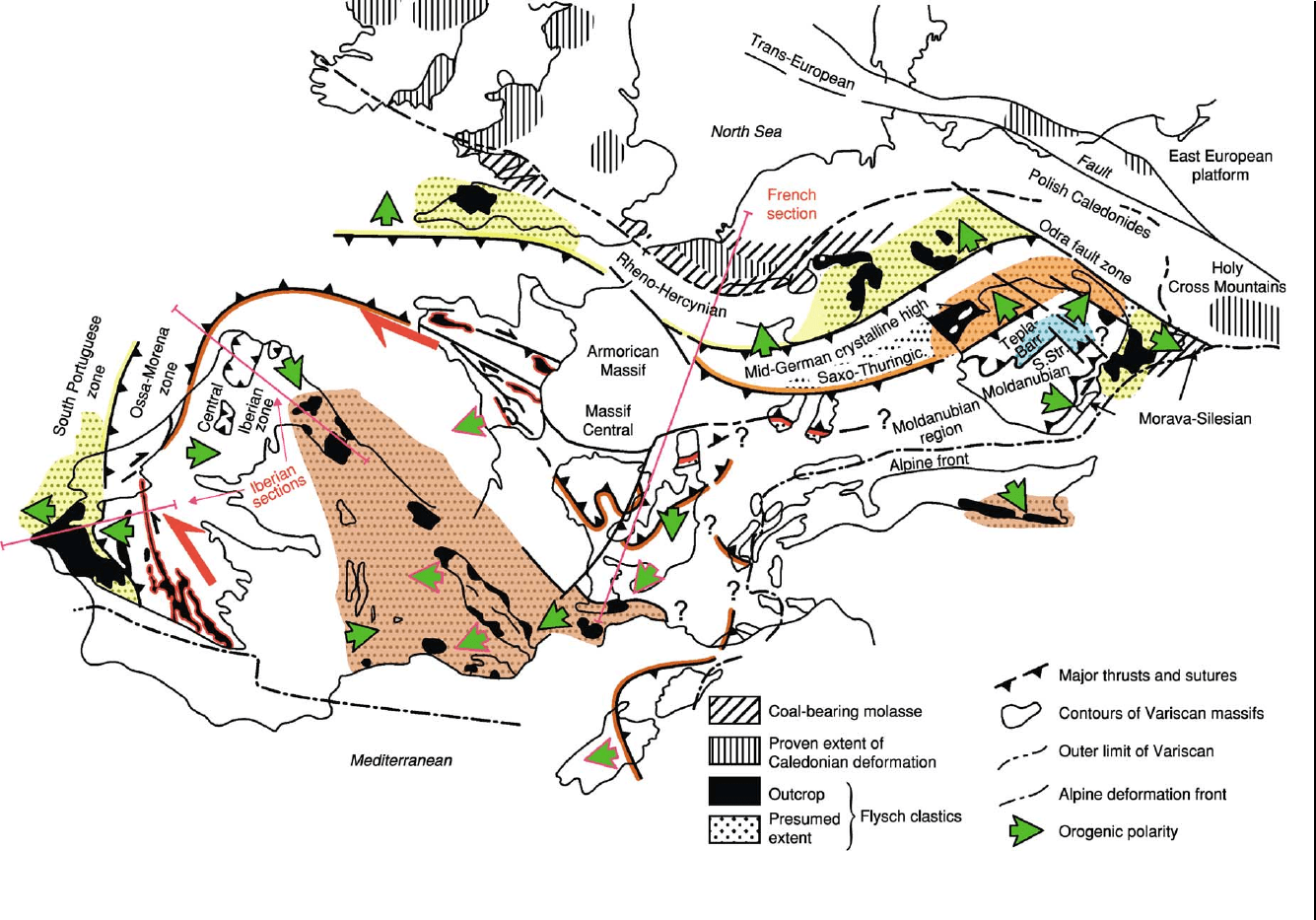
Figure 1 Tectonic and palaeogeographical subdivision of the Variscan basement in Europe, after Frank W (2000) The mid-European segment of the Variscides: tectonostratigraphic units,
terrane boundaries and plate tectonic evolution. In: Franke W, Haak V, Oncken, O, and Tanner D (eds.)
Orogenic Processes: Quantification and Modelling in the Variscan Belt, pp. 35–62. Special
Publication 179. London: Geological Society.
76 EUROPE/Variscan Orogeny
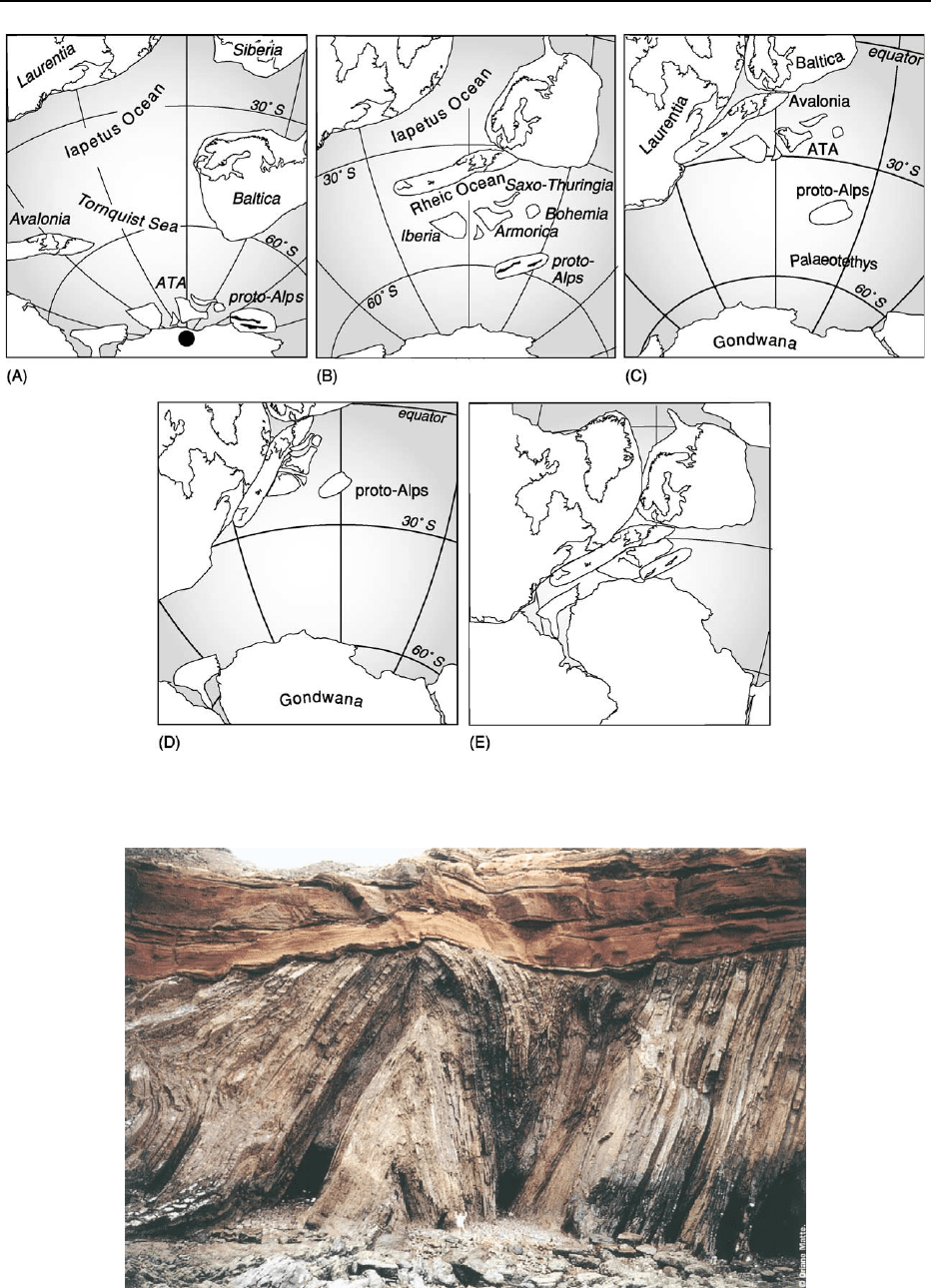
Figure 2 Positions of the continents and microplates bordering the Atlantic in (A) the Early Ordovician, (B) the Late Ordovician,
(C) the Late Silurian, (D) the Middle Devonian, and (E) the Permian based on palaeomagnetic data.
Figure 3 Angular unconformity between folded Late Carboniferous deep-water sandstones and Triassic fluvial deposits. Telheiro
beach near Cabo Sao Vicente, Algarve, southern Portugal. Photograph taken by P. Matte.
EUROPE/Variscan Orogeny 77

the southern border of Eurasia. These terranes include
Avalonia, the Armorican Terrane Assemblage, and the
proto-Alps, which, in Cambrian to Early Ordovician
times, were still attached to the north Gondwanan
margin. Subduction of oceanic crust under this margin
caused the Cadomian orogen (named after Cae
¨
n, the
Roman Cadomus, in Normandy). Cadomian basement
is present in nearly all parts of the Variscan belt.
The positions and drift histories of Gondwana,
Baltica, Laurentia, Avalonia, the Armorica Terrane
Assemblage, and the proto-Alps are now fairly well
constrained by palaeomagnetic data, and faunal and
palaeoclimatic indicators are generally in good agree-
ment. Palaeomagnetic data suggest the following
palaeogeographical evolution (Figure 2).
Cambro-Ordovician
In the Early Ordovician, the northern margin of Gon-
dwana was situated at high southerly palaeolatitudes,
Baltica was situated between 30
Sand60
S and was
inverted with respect to its present-day position, and
Laurentia was in an equatorial position. The Cado-
mian basement rocks of Avalonia and the Armorican
Terrane Assemblage clearly indicate that in Cambrian
times these terranes were contiguous with the northern
margin of Gondwana, and remained marginal to Gon-
dwana until the Early Ordovician. By the late Early
Ordovician (Tremadoc), data indicate that Avalonia
had started to drift northwards, away from Gondwana,
opening the Rheic Ocean in its wake (see Palaeozoic:
Ordovician). It continued to move northwards through-
out the Ordovician, gradually closing the Tornquist Sea
and Iapetus Ocean, which separated it from Baltica and
Laurentia, respectively. Palaeomagnetic data from dif-
ferent elements of the Armorican Terrane Assemblage
indicate a similar, but independent, movement of these
microplates, with separation from Gondwana being
initiated slightly later in the Ordovician. No palaeo-
magnetic data are yet available from Ordovician rocks
of the proto-Alps, but geological evidence suggests a
continued Gondwanan affinity during this period.
Late Ordovician
By the Late Ordovician, Gondwana had moved some
30
northwards, and northern central Africa was
situated over the south pole according to palaeomag-
netic data from western Australia. Baltica was now in
its present-day orientation, and its northern margin
was at the equator. Laurentia, which did not move
much throughout the Palaeozoic, remained strad-
dling the equator and was separated from Baltica
and Gondwana by the Iapetus Ocean. By Ashgillian
times, palaeomagnetic and biogeographical data in-
dicate that the Tornquist Sea, separating Baltica
and Avalonia, had closed. Collision of Avalonia with
Baltica created a narrow belt of deformation and
metamorphism (the Polish Caledonides; Figure 1).
The Rheic Ocean still separated Avalonia/Baltica
from the Armorican Terrane Assemblage, which was
situated at more southerly palaeolatitudes in the Ash-
gillian, based on palaeomagnetic evidence from the
Bohemian Massif. The presence of glaciomarine sedi-
ments and cold-water faunas throughout the Armor-
ican Terrane Assemblage reflects the Late Ordovician
period of global cooling, which enabled the colon-
ization of previously warmer-water realms by cold-
water faunas. It has been shown that these glacial
sediments of central Europe were deposited by sea-
sonal or floating ice, in agreement with palaeomag-
netic data from the Bohemian Massif, which clearly
indicate intermediate to low palaeolatitudes. Strong
faunal and lithological similarities in the Ordovi-
cian–Devonian successions of different massifs of
the Armorican Terrane Assemblage indicate similar
ecological conditions, demonstrating that they were
all part of the same palaeogeographical domain.
The proto-Alps were positioned at higher palaeolati-
tudes, between northern Gondwana and the southern
margin of the Armorican Terrane Assemblage. This
conclusion is based predominantly on faunal evi-
dence, which indicates separation from northern
Gondwana.
Siluro-Devonian
The palaeogeographical position of Gondwana from
Silurian to Late Devonian times remains controversial
on the basis of palaeomagnetic evidence, as two dif-
ferent models have been proposed in the literature.
The more conservative model involves gradual north-
ward movement of northern Gondwana throughout
the Palaeozoic, with final closure of the ocean separ-
ating northern Africa from southern Europe in the
Late Carboniferous. The alternative model is based
primarily on palaeomagnetic data from south-east
Australia and requires rapid northward movement
of Gondwana in the Silurian, followed by rapid south-
erly movement in the Devonian. However, whether or
not it is viable to use palaeomagnetic data from
this region of Australia, whose autochthony with cra-
tonic Australia is questioned, remains open to debate.
In summary, taking all the palaeomagnetic, palaeo-
climatic and biogeographical data into account, the
more conservative model, involving gradual north-
ward movement of Gondwana throughout the
Palaeozoic, is considered more plausible.
Final closure of the Iapetus Ocean between Bal-
tica/Avalonia and Laurentia occurred in the Siluro-
Devonian, after which Baltica and Laurentia (Laurussia)
78 EUROPE/Variscan Orogeny

remained in equatorial palaeolatitudes until the end of
the Palaeozoic era.
Late Silurian–Early Devonian palaeomagnetic data
from a number of different crustal blocks of the
Armorican Terrane Assemblage indicate palaeolati-
tudes of 20
–30
S. This implies gradual migration
towards the southern margin of Baltica/Avalonia
and closure of the intervening Rheic Ocean.
Late Devonian
By the Late Devonian, the Iapetus Ocean between
Laurentia and Baltica/Avalonia had closed. Similarly,
the Rheic Ocean between Avalonia and the Armorican
Terrane Assemblage closed in the late Mid-Devonian.
Closure of the ocean was essentially a longitudinal
process and thus cannot be accurately constrained by
palaeomagnetic data; however, invertebrate faunal dif-
ferences between Bohemia and Avalonia persisted until
the Emsian or Givetian. The now amalgamated Laur-
asian landmass moved southwards in Late Devonian
times, but its northern border remained equatorial.
In Gondwana, however, the Late Devonian remains
one of the more controversial periods. High-quality
palaeomagnetic data from Australia clearly place
central Africa over the south pole, requiring an ocean
between the northern margin of Gondwana and the now
amalgamated Laurasia. Faunal data from the southern
Alps show poor similarity with the coeval fauna of
northern Africa, and the sedimentary sequences of the
southern Alps reflect a period of continuous sedimen-
tation until the Late Carboniferous, with little evi-
dence of any major deformation until Carboniferous
times. However, the similarity of the fossil fish records
of Gondwana (Australia) and Laurasia suggests that
there was no oceanic separation of these two contin-
ents from late Early Devonian times onwards. These
discrepancies in the faunal record, and between biogeo-
graphical and palaeomagnetic evidence, remain, as
yet, unresolved. Nevertheless, there is general consen-
sus that the collision of Gondwana with Laurasia to
form the supercontinent Pangaea occurred in Late
Carboniferous to Permian times.
A modern analogue of Palaeozoic plate dispersal
might be the Indian Ocean: like Avalonia and the
Armorican blocks, India, the Seychelles, and Mada-
gascar have separated from Africa and, at least partly,
made their way towards Asia (Laurussia).
Geological Record: Central Europe
Geological observations provide more detailed
information about the plate-tectonic processes in-
volved. Figure 4 is a diagrammatic representation of
the plate-kinematic evolution of central Europe.
Northward migration of the Armorican Terrane
Assemblage was accommodated by northward-
directed subduction of the Rheic Ocean beneath the
southern margin of Avalonia, forming a magmatic
arc, which is now preserved in the Mid-German Crys-
talline High (Figures 1, 4, and 5). By the late Early
Devonian, the Rheic Ocean had more or less closed.
At the same time, narrow oceans or seaways between
the Armorican islands – Saxo-Thuringia and Bohemia –
and between Bohemia and Moldanubia (possibly rep-
resenting northern Gondwana) were being closed. The
generally convergent movements were interrupted only
by renewed extension along the Avalonia–Armorica
boundary, creating a new narrow oceanic basin (the
Rheno-Hercynian Ocean) whose remains can be traced
from southern Portugal via south-west England and
the Rhenish Massif into the Harz Mountains, with
an easterly extension into Moravia (Figure 1).
The Rheno-Hercynian Ocean closed from the late
Middle Devonian onwards, thus joining in the general
convergence. The final collision of Avalonia with Fran-
conia (the northernmost Armorican terrane) occurred
in the earliest Carboniferous. Collision between the
Armorican terranes further south (Saxo-Thuringia, Bo-
hemia, and Moldanubia) took place in Late Devonian
times.
Plate convergence was accommodated by a bilat-
eral array of subduction or collision zones: the narrow
Rheno-Hercynian and Saxo-Thuringian oceans were
subducted towards the south, while the seaway be-
tween Bohemia and Moldanubia was subducted
towards the north. This resulted in three collisional
belts: the Rheno-Hercynian, Saxo-Thuringian, and
Moldanubian (Figure 5), which were originally
proposed by F Kossmat in 1927.
Collision resulted in the exhumation of previously
subducted oceanic and continental rocks, which were
emplaced as thrust sheets over the foreland areas. In
each of the three collisional belts, the frontal thrust
migrated towards the foreland, thus accreting fore-
land rocks to the orogenic wedge (Figure 5). Thrusting
and folding reduced the widths of the original micro-
plates considerably: collisional shortening in the three
belts amounts to a minimum of ca. 800 km. This
figure does not include the unknown width of oceanic
crust subducted between the microplates.
Foreland basins filled with synorogenic clastic
debris migrated ahead of the tectonic fronts. In the
Rheno-Hercynian Belt, deposition kept pace with
subsidence, so that sedimentation occurred in a shal-
low-marine to fluvial environment. The extensive
coastal forests that developed in these tropical regions
provided the raw material for economically import-
ant coal seams, which are exploited in Wales, the
northern part of the Rhenish Massif, and Silesia
(Figure 1).
EUROPE/Variscan Orogeny 79
